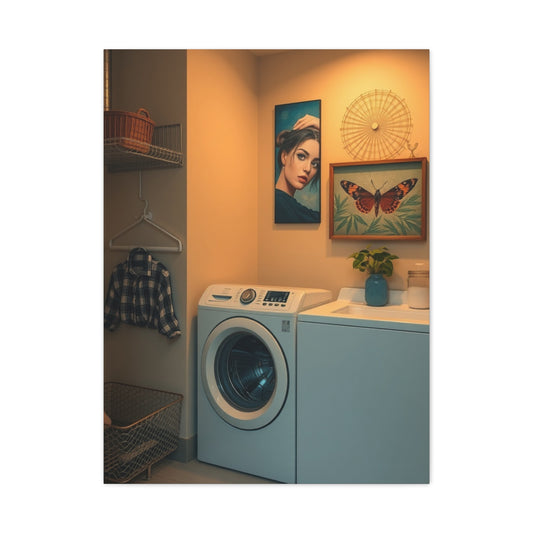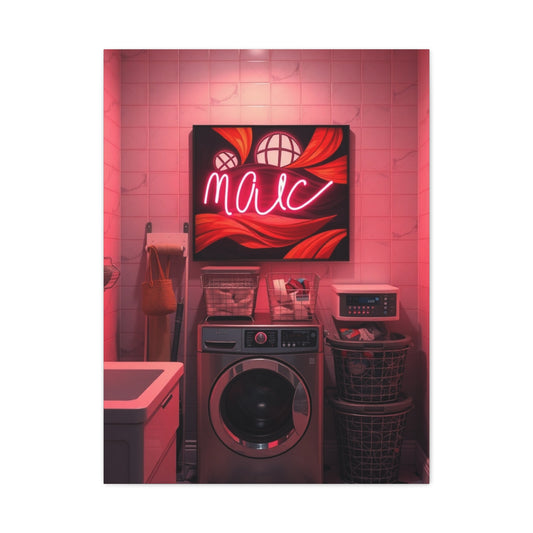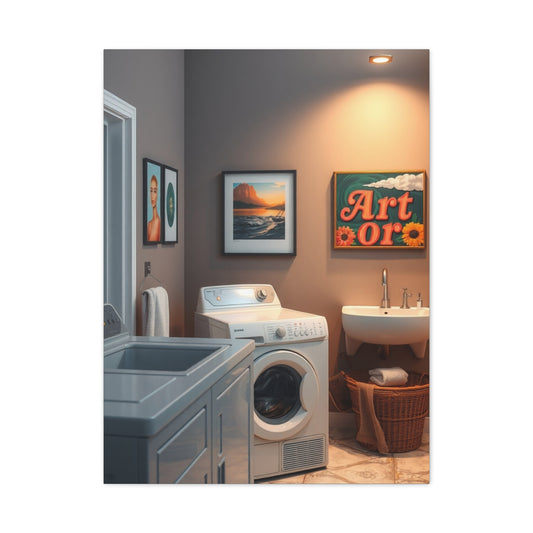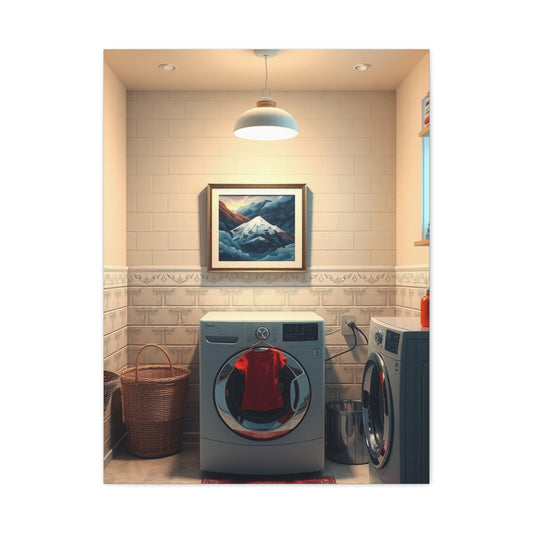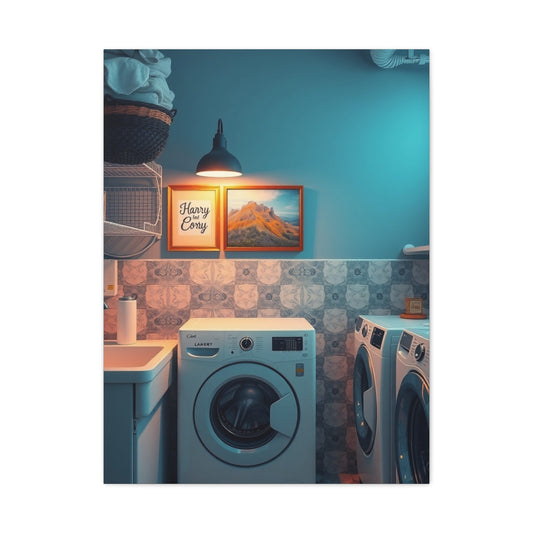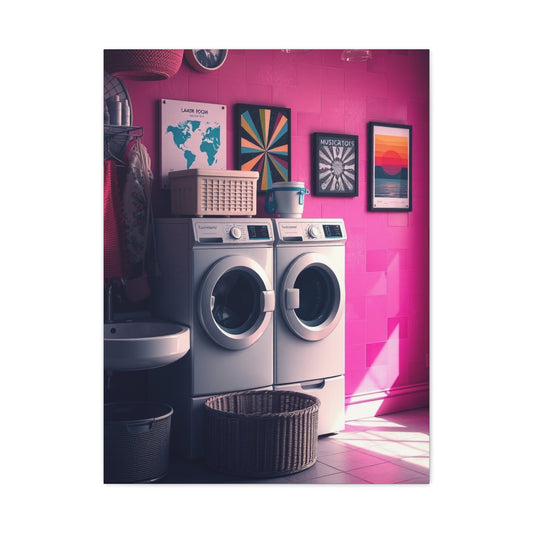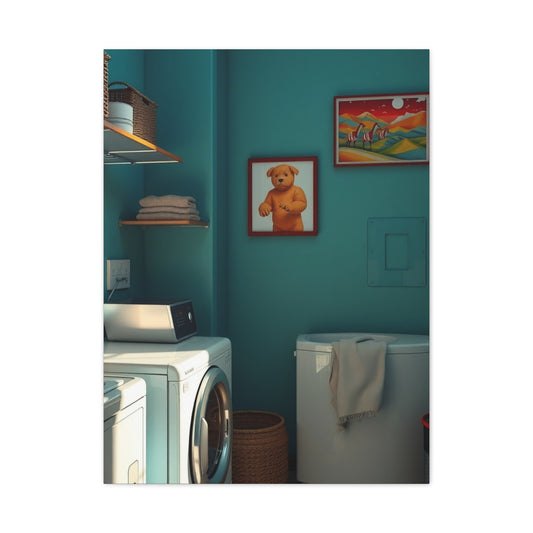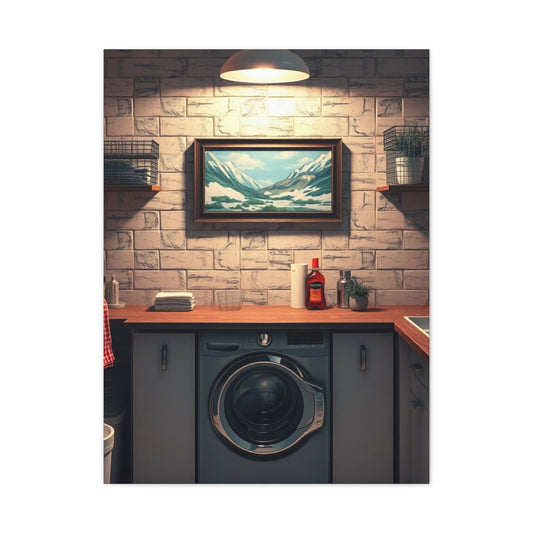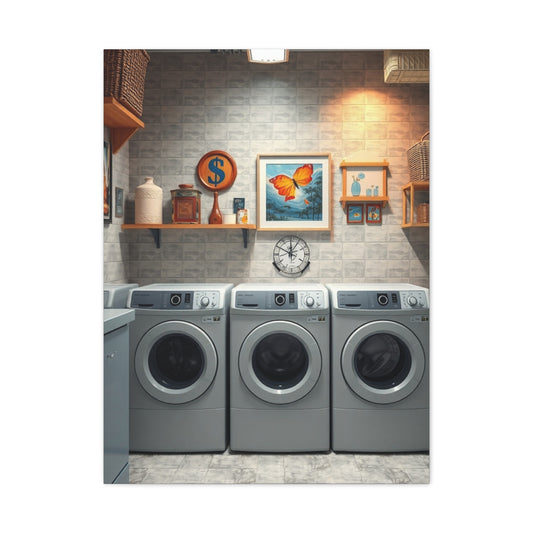Laundry Room Wall Art Ideas That Blend Function with Style
Whoever said the laundry room had to remain a purely utilitarian space has not experienced the shift in interior design philosophies of recent years. As homes evolve into sanctuaries, every room—no matter how small or functional—becomes an opportunity for expression. The laundry room, once hidden away and overlooked, is now finding its place within the modern household as a stage for creativity, color, and carefully chosen art. By infusing decorative elements and thoughtfully curated wall art, this once-neglected corner of the house can blossom into a lively retreat where chore meets charm.
The year 2025 brings an array of exciting approaches to interior décor that balance modernity with nostalgia, and the laundry room is no exception. The clean lines of contemporary design merge with expressive artwork, creating harmony between function and visual delight. Families are embracing the idea that the laundry room should inspire serenity while remaining practical, and wall art is one of the most powerful tools for achieving this transformation. Whether through abstract canvases, botanical prints, minimalist typography, or whimsical washing symbols, wall décor adds texture and spirit to the space.
This guide explores not only the aesthetics but also the deeper context of laundry room wall décor. From historical influences to emerging trends, from foundational design concepts to practical applications, we will traverse the artistic journey of turning a utilitarian space into a curated haven. By the end, you will discover that decorating a laundry room is not just about surface beauty—it’s about cultivating a daily ritual surrounded by art that elevates the atmosphere.
Historical Background
Though the laundry room may seem like a contemporary invention, spaces dedicated to washing clothes have existed in various forms for centuries. In traditional societies, washing was often a communal act conducted by rivers or wells. Artistic flourishes were unnecessary then, as nature itself provided the backdrop. Yet, as domestic life shifted indoors, especially in the late nineteenth and early twentieth centuries, specialized laundry areas began to emerge within the architecture of the home.
During the Victorian era, practicality reigned, and décor was sparse. Laundry spaces were located in basements, often dark and purely functional. Wall decoration rarely extended to such utilitarian rooms, as households reserved their ornamental flair for parlors, dining rooms, or drawing rooms. However, traces of design sensibilities seeped in—ornamental tiles, utilitarian enamel signs, and functional illustrations that depicted washing instructions became precursors of today’s wall art in laundry spaces.
The mid-twentieth century saw a shift, particularly during the rise of suburban homes in the 1950s and 60s. With laundry rooms becoming a standard feature, manufacturers of appliances also introduced promotional posters, cheerful color schemes, and stylized motifs that brought visual interest. Decorative flourishes often included playful depictions of detergent brands, cheerful housewives, and mid-century typography.
By the late twentieth century, the concept of home décor expanded into every room, leading to a reevaluation of neglected spaces like mudrooms, pantries, and laundry areas. The 1990s and early 2000s emphasized efficiency, with wall art remaining secondary to cabinetry and storage. Yet, as modern lifestyles began emphasizing mindfulness and home aesthetics, the tide turned again.
Today, the laundry room has fully entered the realm of interior design. It is not only a place to clean garments but also a symbolic extension of personal style. Wall art, once deemed frivolous in such spaces, now provides cultural commentary, personal expression, and harmony with broader home aesthetics. The historical evolution from neglected utility to intentional design mirrors our changing relationship with the home itself: no longer a shelter alone but a curated canvas for everyday living.
Core Concepts and Foundations
At the foundation of laundry room wall décor lies a dialogue between functionality and aesthetics. Unlike living rooms or bedrooms, laundry areas must prioritize efficiency and accessibility. However, the environment can still be elevated with carefully chosen wall art that enhances rather than distracts. The core principles of laundry room decoration revolve around balance, cohesion, symbolism, and emotion.
One foundational idea is that wall décor should harmonize with the architectural structure of the room. This means acknowledging the size, lighting, and layout. In smaller laundry rooms, oversized art might feel overwhelming, whereas in larger utility rooms, expansive canvases or multi-panel artworks can create proportionate visual impact.
Color psychology is also a fundamental component. Since laundry rooms are associated with cleanliness and renewal, hues like crisp white, calming blue, soft gray, or fresh green dominate wall art choices. Yet bold pops of color through abstract or typographic designs can invigorate the space, making it feel lively rather than monotonous.
Symbolism plays a subtle role as well. Laundry-themed art featuring washing symbols, humorous quotes, or botanical imagery creates thematic resonance. Such décor reminds us that even ordinary chores are part of life’s rhythm, and when accompanied by art, they gain an aura of ritual.
Materiality forms another foundation. A framed canvas adds sophistication, while unframed pieces introduce flexibility and a casual feel. Texture matters too; prints on wood, metal, or fabric bring tactile variety. These materials not only influence the aesthetic but also determine durability in humid laundry environments.
Underlying all these ideas is the emotional connection. A laundry room should feel inviting and less burdensome. Wall art contributes to this by fostering moods—calm through landscapes, joy through playful slogans, focus through geometric designs, and freshness through florals. The foundation of laundry wall décor, therefore, is not merely visual but experiential, altering how one perceives and engages with routine chores.
Types and Categories
In 2025, laundry room wall décor is defined by an eclectic mix of styles, each with its own character and purpose. Understanding the categories of wall art available helps in curating a space that resonates with personal taste while aligning with contemporary trends.
One prominent category is typographic art, which includes witty phrases, laundry puns, or simple words like “Wash,” “Dry,” or “Fresh.” These pieces lean on minimalism but add a dose of humor and charm. They often employ monochrome palettes, though modern interpretations experiment with vibrant typography against neutral walls.
Another category is botanical and natural prints. Leaves, flowers, and abstract representations of nature align with the broader 2025 trend of organic living. A botanical print softens the mechanical character of washing machines and dryers, bringing warmth and life to the room. This category appeals particularly to those seeking a balance between modern function and natural beauty.
Abstract art has become increasingly popular in laundry spaces, offering versatility and modern flair. Through splashes of color, geometric patterns, or textural depth, abstract prints infuse dynamism without being overly thematic. Their ambiguity allows them to complement different décor styles, from minimalist Scandinavian to eclectic bohemian.
Playful symbolic art forms yet another category, with washing symbols, detergent illustrations, or quirky caricatures creating a lighthearted vibe. These designs inject character while reminding users of the function of the space. This approach transforms mundane symbols into decorative statements.
Then there is multi-panel canvas art, which is less about subject matter and more about format. Splitting a single image across multiple canvases adds a modern, fragmented effect that suits larger laundry rooms. The panels can depict anything from serene landscapes to bold abstracts, offering both cohesion and dramatic flair.
Finally, personalized art is gaining momentum. Customized prints with family names, monograms, or personal motifs transform the laundry room into a distinctly individual space. In an age where personalization defines luxury, this category allows homeowners to make the utility space uniquely their own.
These categories demonstrate the versatility of laundry room wall décor in 2025. By mixing and matching—perhaps a botanical print paired with typographic humor—one can craft a space that reflects both personal taste and contemporary style.
Practical Applications
Understanding concepts and categories is only half the journey; applying them effectively is the key to transforming your laundry room. Practical applications begin with assessing the dimensions of the space. Wall art should occupy sixty to seventy-five percent of the available wall area, not obstructed by shelving or cabinetry. This ensures the art feels integral rather than an afterthought.
Placement is equally important. In narrow laundry rooms, artwork above the appliances provides a focal point, while in larger spaces, art can flank shelving or be arranged as a gallery wall. Symmetry works well when striving for balance, whereas asymmetry injects modern energy.
Framed versus unframed canvases must also be chosen based on the desired aesthetic. Framed prints exude elegance and a gallery-like atmosphere, whereas unframed pieces emphasize modern minimalism. Consider the surrounding furniture and cabinetry—if they are ornate, an unframed canvas may provide contrast, while sleek storage pairs well with framed refinement.
Lighting enhances the impact of wall art. Natural light invigorates botanical or pastel prints, while spotlights or sconces can highlight darker abstract pieces. Installing subtle lighting above art not only improves visibility but also creates ambiance, turning the laundry room into a mini-gallery.
Practicality must never be ignored. Since laundry rooms may encounter humidity, choose art printed on durable materials with protective coatings. Avoid delicate paper prints unless placed in protective frames. Canvas, metal, or acrylic are resilient and suited for functional spaces.
Another practical tip involves coordination with color palettes. If the laundry room follows a white and teal scheme, ensure that the wall art either complements or intentionally contrasts. Cohesion across baskets, storage bins, and art unifies the space, while a deliberate pop of contrast can inject vibrancy.
Even the subject matter can serve a functional role. For example, playful washing symbol art doubles as a guide for interpreting clothing labels, blending education with design. Similarly, typographic prints can serve as gentle reminders of household routines.
Ultimately, practical application is about making the laundry room both stylish and livable. Wall art is not an isolated component but part of a larger choreography that integrates cabinetry, flooring, lighting, and textiles into a cohesive, inviting environment.
Techniques and Methods
Selecting and applying wall art in the laundry room is an artistic process that combines both precision and creativity. Techniques involve not just the choice of artwork but also the way it is positioned, layered, and integrated with the existing architectural features. Methods vary according to personal style, room size, and the mood one wishes to evoke, but the overarching principle is always cohesion.
One primary technique is the gallery wall approach, where multiple smaller pieces are arranged together. This method works well in narrow laundry spaces, transforming a blank wall into a curated collection. Symmetry can produce a polished appearance, while asymmetry introduces spontaneity and energy. The trick is to maintain a visual rhythm—spacing between frames should be consistent, and the overall shape of the arrangement should feel balanced.
Another effective method is the statement piece technique, in which one large artwork dominates the wall. This works particularly well in modern laundry rooms with minimalist cabinetry. A single oversized botanical print, abstract canvas, or typographic design can anchor the space and establish a focal point. This technique is especially impactful when the surrounding décor is subdued, allowing the artwork to shine.
Layering is also an increasingly popular method. Rather than relying solely on hung artwork, designers experiment with mixed media layers such as leaning frames, wall-mounted shelves with small art objects, and even textile hangings that double as wall décor. By combining different materials—wood, canvas, fabric—layers create depth and texture, enriching the sensory experience of the room.
Positioning is another crucial method. Art placed at eye level is most engaging, but in laundry rooms where appliances may occupy the lower half of the space, artwork is often hung slightly higher to align with sightlines. Vertical positioning can elongate the room visually, while horizontal arrangements make narrow rooms appear wider. Designers also use negative space strategically, leaving intentional gaps around artwork so that the room feels airy rather than cluttered.
Color-coordination techniques bring another dimension. One method is to select art that mirrors existing tones in the room, such as matching the blues of a painting with teal cabinetry. Another is the contrast method, where vivid artworks stand out against a neutral backdrop. For example, a bright coral or citrus-toned canvas can add zest to a predominantly white laundry room.
Finally, framing itself can be treated as a method. A sleek black frame emphasizes structure, while natural wood introduces warmth. Floating frames create a museum-like effect, while frameless canvases lean toward contemporary casualness. Each method alters the overall personality of the room, proving that presentation is as important as the art itself.
Challenges and Common Mistakes
While decorating a laundry room can be invigorating, it also presents challenges. Many homeowners overlook certain practicalities, resulting in design missteps that reduce both functionality and beauty. Recognizing common mistakes can prevent disappointment and ensure a harmonious outcome.
One frequent error is ignoring proportions. Large, overpowering artworks in small laundry rooms can feel suffocating, while tiny prints on expansive walls appear lost. Proportion must always be considered relative to available wall space and surrounding furniture. Measuring before purchasing artwork is essential to avoid imbalance.
Another challenge lies in choosing fragile materials. Laundry rooms are prone to moisture and fluctuating temperatures. Artwork printed on delicate paper or mounted without a protective coating may warp or fade. Opting for durable mediums like canvas, metal, or acrylic prevents long-term damage.
Overdecorating is another pitfall. Because laundry rooms are typically compact, excessive wall décor can create visual clutter. Artworks should complement rather than overwhelm the space. A few well-chosen pieces often make a stronger statement than an abundance of mismatched ones.
The neglect of lighting is a subtle but significant mistake. Even striking art loses its charm if poorly illuminated. Relying solely on ceiling fixtures without directed lighting can leave pieces in shadow. Ideally, accent lights or wall sconces should be incorporated to highlight the artwork’s details and create ambiance.
Color misalignment is a common issue as well. Choosing art without regard to the existing palette can result in dissonance. For instance, a brightly saturated abstract may clash with muted cabinetry, disrupting cohesion. A simple solution is to carry a swatch of wall paint or textile when selecting art, ensuring harmony.
Practical accessibility is often overlooked. Art positioned in places that interfere with storage access or create obstructions can frustrate daily routines. The key challenge is balancing aesthetics with usability so that the room remains efficient.
Finally, a subtle mistake is the lack of thematic connection. The most compelling laundry room designs weave a narrative where art resonates with the function of the space. Choosing generic pieces without considering this connection may result in décor that feels disconnected. A thoughtful approach, whether through washing symbols, botanical freshness, or playful typography, ensures that the art reinforces the essence of the room.
Trends and Future Outlook
The evolution of laundry room décor reflects broader cultural shifts in lifestyle, sustainability, and aesthetics. Looking ahead to 2025 and beyond, several trends are shaping how homeowners approach wall art in utility spaces.
One prominent trend is eco-inspired art. As sustainability continues to dominate the design conversation, artworks featuring recycled materials, botanical imagery, and earthy tones are on the rise. Laundry rooms, symbolic of renewal and cleanliness, are ideal spaces for art that echoes environmental consciousness.
Another trend is digital integration. Interactive screens or digital canvases displaying rotating art collections are gaining popularity. Such technology allows homeowners to change artwork seasonally or daily without physical replacements, offering versatility and novelty. This fusion of art and technology aligns with the increasingly smart-home culture.
The return of craftsmanship is also notable. Hand-painted signs, artisanal textile hangings, and bespoke wall pieces are becoming sought after. In a world saturated with mass production, unique handmade art adds authenticity and character to the laundry room.
Color trends are also shifting. Neutrals remain foundational, but accent tones are evolving. Deep emeralds, terracotta, and sunset hues are predicted to make their mark in 2025, offering alternatives to the familiar pastels of previous years. Wall art adopting these palettes introduces warmth and sophistication.
Minimalism continues, but it is evolving into what designers call warm minimalism. This approach favors clean lines and uncluttered spaces but incorporates natural textures and soft tones. Wall art plays a pivotal role in this movement, often using simple geometric forms or organic illustrations to achieve understated elegance.
Cultural symbolism is another future outlook. Art reflecting global motifs—such as Japanese wabi-sabi, Mediterranean patterns, or Scandinavian simplicity—will enrich laundry spaces with multicultural layers. This trend highlights the interconnectedness of global design inspirations.
Finally, personalization is expected to dominate. As digital printing becomes increasingly accessible, customized laundry art featuring family names, personal mantras, or bespoke designs will become more widespread. The future of laundry décor is one where individuality reigns, transforming every home into a distinctive story.
Expert Insights
Expert voices provide valuable guidance when navigating the balance between form and function in laundry room décor. Interior designers, art curators, and architects all emphasize that art is not a superficial addition but a vital element that shapes the user’s emotional experience of the space.
Interior stylist Elimar Lobo Sáenz stresses the significance of simplicity: “The most successful laundry room designs allow for breath. Wall art should not suffocate the space but create visual pauses that make the routine of washing clothes feel less mechanical and more meditative.” Her advice highlights the importance of restraint, urging homeowners to avoid excess and focus on intentionality.
Art director Tirzah Goodman, known for curating modern home décor trends, advocates for thematic resonance. “When we decorate a laundry room, we are not simply placing images on a wall. We are telling a story about renewal, rhythm, and everyday life. Choosing art that resonates with these themes ensures the room feels purposeful rather than decorative for decoration’s sake.” Her words underscore the role of symbolism in laundry spaces.
Architectural expert Jonas Richter provides a practical angle: “Placement is as vital as selection. An artwork misplaced can disrupt spatial flow. In utility rooms, think not only of sightlines but of accessibility. Place art where it enhances the rhythm of movement rather than obstructs it.” His insight reminds us that décor must integrate seamlessly with daily usability.
Curator Elena Marquez adds a cultural perspective: “The laundry room is becoming an unlikely stage for cultural storytelling. Clients increasingly choose art with motifs that connect them to heritage, whether Mediterranean tile patterns or botanical sketches reminiscent of ancestral traditions. This trend enriches even the smallest corners of the home with narrative weight.”
Together, these experts reveal that laundry room wall décor is not trivial—it is an opportunity to infuse beauty, meaning, and intentionality into the routines of life. As art migrates from galleries into everyday spaces, even the most mundane tasks acquire a sense of dignity and delight.
Emerging Trends in Wall Art
The world of interior design thrives on reinvention, and nowhere is this more apparent than in the rise of creative wall art. The year 2025 brings a unique fusion of tradition and modernity, resulting in trends that feel both familiar and refreshingly novel. In laundry rooms, these emerging directions are transforming functional spaces into curated sanctuaries of style.
One of the most pronounced trends is the rise of organic motifs. Nature-inspired art, with its leaves, blossoms, and natural textures, has gained momentum as households embrace wellness-oriented living. In laundry rooms, where the act of cleansing and renewal is symbolic, botanical imagery creates harmony between human routines and the natural world. Prints depicting wildflowers, ferns, or abstracted foliage are expected to dominate this season.
Another trend is playful typography. While typographic art has long been popular, 2025 emphasizes wit and personality. Homeowners are moving away from generic motivational quotes, opting instead for witty phrases, cheeky laundry puns, or minimalist lettering that captures the essence of the space. These pieces lighten the mood, reminding us that even mundane chores can be accompanied by humor.
The multi-texture movement is also shaping the landscape. Rather than limiting wall décor to printed canvases, designers are experimenting with textile art, woven hangings, and wooden reliefs. These tactile elements add depth and dimension, ensuring that the laundry room feels warm and inviting rather than sterile. By integrating multiple textures, the space resonates with artisanal charm.
Color also plays a central role in emerging trends. Muted pastels with bold accents are gaining traction, as they strike a balance between serenity and vibrancy. A canvas in soft sage green may be paired with a vivid coral accent piece, creating a dialogue between calm and energy. This approach reflects the contemporary philosophy that interior design should both soothe and stimulate.
A fascinating trend is cultural storytelling through art. Laundry rooms are becoming sites for expression beyond utility, with wall art reflecting global traditions. Mediterranean tile-inspired prints, Japanese minimal brushwork, or African geometric patterns bring heritage into the home. These influences infuse character into even the smallest spaces, connecting household routines to broader cultural narratives.
Finally, technology is emerging as a frontier. Digital art displays allow homeowners to cycle through multiple artworks on a single screen, providing versatility for changing moods or seasons. In 2025, smart frames that connect to online galleries are gaining traction, making it possible to refresh laundry room décor with a touch of a button. This convergence of digital innovation and timeless artistry speaks to the adaptability of modern living spaces.
Step-by-Step Guides
Decorating a laundry room can feel daunting, especially when balancing function with style. A structured approach helps transform the process into an enjoyable journey. Below are comprehensive step-by-step guides to help you create a laundry room that feels both practical and artfully adorned.
Step 1: Assess the Space
Begin by evaluating the size, layout, and natural lighting of your laundry room. Measure wall dimensions, noting any obstructions such as shelving, windows, or cabinets. The available surface area will determine whether a single statement piece or a gallery wall is more appropriate. Observing the flow of natural light also helps in selecting colors and finishes that will look harmonious throughout the day.
Step 2: Define the Mood
Every room conveys emotion, and wall art is central to establishing that atmosphere. Decide whether you want your laundry room to feel tranquil, playful, energizing, or refined. A tranquil mood may call for soft botanical prints, while a playful atmosphere benefits from witty typography or cheerful illustrations. Defining the mood ensures your choices remain cohesive and intentional.
Step 3: Choose a Color Palette
Color is the invisible thread that ties décor together. Start with a base color already present in the room—such as cabinetry or flooring—and build upon it. If your laundry room features white cabinetry, you might introduce blues and greens for freshness. If darker wood dominates, warm tones like terracotta or golden hues can add brightness. The chosen palette should be reflected in wall art, textiles, and accessories to unify the design.
Step 4: Select the Type of Wall Art
With a clear mood and palette, determine the style of wall art that aligns with your vision. If minimalism appeals, opt for simple abstract canvases or geometric prints. For those who prefer vibrancy, multi-panel artworks or colorful botanical designs may be more suitable. Playful households might gravitate toward laundry-themed symbols or humorous typography. The key is to select art that resonates with personal taste while complementing the function of the room.
Step 5: Decide on Format and Size
Proportions are critical. Use the guideline of filling approximately sixty to seventy-five percent of the available wall space with artwork. For a narrow wall, vertical formats work best, while wide walls accommodate horizontal or multi-panel designs. If uncertain, create paper cutouts of potential sizes and tape them temporarily to the wall to visualize the effect before purchasing the final pieces.
Step 6: Consider Framed vs. Unframed
Frames influence the personality of the artwork. A framed print adds sophistication, often giving the illusion of depth. Black or metallic frames evoke modernity, while natural wood feels rustic and organic. Unframed canvases, on the other hand, provide a contemporary, casual touch that suits minimalist interiors. Choose the option that aligns with your overall style.
Step 7: Experiment with Placement
Before committing, experiment with placement. Lay artworks on the floor to simulate gallery wall arrangements or test spacing with removable adhesive hooks. Consider sightlines—art should be visible from the main entry into the room. Positioning art slightly higher than eye level can be effective in laundry rooms, as appliances often dominate the lower half of the space.
Step 8: Enhance with Lighting
Lighting transforms wall art from static decoration into a vibrant focal point. Install track lighting, sconces, or LED strips to illuminate pieces. Ensure the lighting highlights colors and textures without casting harsh shadows. Natural light should also be considered, as morning sun or afternoon shade will alter the perception of the artwork throughout the day.
Step 9: Balance Art with Storage
Laundry rooms must remain functional, so avoid placing art where cabinets or baskets need to be accessed. Consider integrating art above storage units, next to open shelving, or in spaces where it will not be obscured by daily use. The goal is harmony between function and beauty.
Step 10: Add Personal Touches
Incorporate art that reflects individuality. Personalized prints, monograms, or artworks that echo family values turn the laundry room into a unique haven. Even small gestures, such as hanging a handcrafted textile or a vintage detergent poster, add personality and story to the space.
Step 11: Maintain and Refresh
Wall art should not remain static. Just as seasons change, rotating pieces can breathe fresh life into the room. Store alternate artworks and swap them periodically to keep the space engaging. For digital displays, updating imagery regularly ensures the laundry room always feels current.
Step 12: Evaluate the Atmosphere
Once the décor is complete, take a step back and evaluate how the room feels. Does the artwork create the desired mood? Is it proportionate and harmonious? Does it enhance rather than hinder functionality? Reflection is essential to ensure that design choices align with both aesthetics and practicality.
Personalization and Character in Wall Art
Every dwelling tells a story, and the laundry room should not be excluded from that narrative. In 2025, personalization has become a cornerstone of design, allowing homeowners to transform practical corners into reflective spaces brimming with identity. Wall art is one of the most effective ways to achieve this, turning an ordinary backdrop into a visual autobiography.
Personalized artwork might take the form of family photographs reimagined as minimalist sketches, bespoke canvases commissioned from local artists, or monograms that subtly echo heritage. Unlike generic decorative items, these pieces infuse character and provoke sentiment. The laundry room, often associated with repetitive tasks, becomes a site for connection when adorned with imagery that reminds residents of cherished memories, shared laughter, or creative pursuits.
Cultural heritage also plays a key role in this process. Incorporating motifs from ancestral traditions, whether it is Mediterranean mosaic patterns, South Asian mandalas, or Scandinavian linework, enriches the environment with symbolism and pride. By merging family history with contemporary aesthetics, wall art embodies a continuum that bridges past and present.
Sustainability and Conscious Choices
In recent years, the intersection between sustainability and design has gained prominence, and laundry room wall decor is no exception. Eco-conscious households are shifting toward artwork made from recycled, repurposed, or sustainably sourced materials. Artists are exploring media such as reclaimed wood, natural fibers, and biodegradable pigments, allowing wall art to serve as both decoration and ethical statement.
Supporting artisans who use fair-trade practices also contributes to a sense of responsible living. Choosing handmade weavings or reclaimed metal sculptures not only elevates the laundry room’s atmosphere but also ensures that the décor aligns with the values of environmental stewardship. Conscious decisions remind us that aesthetics need not be divorced from responsibility, and each curated wall becomes a reflection of both artistry and care for the planet.
Balancing Minimalism and Ornamentation
Design philosophies often oscillate between extremes, but 2025 reveals a trend toward balance. Laundry room wall art thrives when minimalism and ornamentation coexist harmoniously. Minimalism, with its uncluttered lines and restrained palettes, ensures serenity and order. Ornamentation, with its intricate patterns and decorative flourishes, injects vitality and richness.
The key is moderation. A single ornate mirror framed with carved wood can complement minimalist walls painted in neutral tones. Alternatively, a series of abstract line drawings can soften a richly patterned backsplash. The juxtaposition creates rhythm, preventing monotony while avoiding chaos. For laundry rooms, which demand efficiency, this duality ensures that the space remains functional while offering visual delight.
Emotional Impact of Wall Decor
Art has always possessed the power to influence mood, and in laundry rooms, the effect is particularly pronounced. Where repetitive tasks may otherwise feel monotonous, the right wall art introduces levity, calm, or inspiration. For example, pastel-hued landscapes can instill tranquility, while bold typographic prints spark amusement.
The psychology of color plays a critical role. Blues and greens offer a sense of renewal, perfectly aligning with the cleansing symbolism of laundry. Yellows and oranges bring cheerfulness, brightening routines on dreary days. Neutrals cultivate calm, grounding the space with simplicity. Understanding these emotional undertones enables homeowners to curate walls that not only appeal to the eye but also uplift the spirit.
Integration with Functional Design
Laundry rooms are inherently utilitarian, but functionality need not exclude artistry. Wall art can be strategically integrated with functional design elements to create synergy. Chalkboard or whiteboard panels framed as decorative pieces can double as organizational tools, allowing schedules or reminders to coexist with aesthetic charm. Pegboards, adorned with artistic motifs, can hold laundry supplies while contributing to the visual composition.
Even shelving can become part of the artistic expression when styled thoughtfully. Positioning small framed artworks alongside jars of clothespins or woven baskets blurs the boundary between storage and decoration. This integration reflects a modern philosophy in which décor is not an afterthought but an intrinsic part of the room’s architecture.
The Future of Wall Art in Everyday Spaces
Looking beyond the present moment, it is clear that laundry room wall art will continue to evolve in tandem with broader cultural currents. As technology advances, interactive art forms may become commonplace, allowing residents to change imagery with gestures or customize designs in real time. Augmented reality might one day overlay digital patterns directly onto walls, merging the physical and the virtual in seamless ways.
Simultaneously, there will likely be a renewed appreciation for handcrafted works. As digital life becomes increasingly pervasive, tangible art forms will provide grounding. Embroidered panels, hand-painted tiles, and carved wooden plaques will serve as antidotes to ephemeral virtual visuals. The oscillation between innovation and tradition will ensure that laundry room wall decor remains dynamic and relevant for decades to come.
Curating an Enduring Style
Trends shift, but timelessness lies in careful curation. To achieve an enduring style, homeowners should invest in pieces that resonate deeply rather than fleetingly. Classic botanical illustrations, monochromatic sketches, or artisanal crafts hold their charm long after trends fade. Mixing these timeless pieces with seasonal accents enables flexibility without losing cohesion.
Placement is equally important. A thoughtfully chosen focal point above the washer and dryer can remain constant, while supplementary pieces rotate with fashion or mood. This layered approach creates continuity, ensuring that the laundry room remains both adaptable and anchored in identity.
Conclusion:
The journey through the evolving world of laundry room wall decor reveals a compelling truth: even the most practical spaces deserve artistry. What was once considered purely utilitarian now emerges as a canvas for creativity, heritage, and self-expression. Wall art infuses laundry rooms with narrative, emotion, and individuality, elevating routine into ritual.
By embracing personalization, sustainable choices, and a balance between minimalism and ornamentation, homeowners can craft spaces that reflect both aesthetic aspirations and ethical commitments. Integrating art with functionality ensures that design enhances rather than obstructs utility. Exploring color psychology, cultural storytelling, and tactile textures enriches the atmosphere, proving that art can transform even the humblest of rooms.
As trends continue to evolve, the laundry room of 2025 symbolizes a larger cultural shift: the recognition that beauty belongs in every corner of domestic life. Whether through witty typography, serene landscapes, or handcrafted artifacts, wall decor reminds us that artistry and daily chores are not mutually exclusive but mutually enriching. In the quiet rhythm of washing and folding, walls adorned with meaningful art invite reflection, joy, and inspiration. They whisper that design is not confined to grand salons or curated galleries but thrives in the ordinary spaces where life unfolds.
The conclusion is clear: laundry room wall decor is not about decoration alone, but about imbuing the everyday with wonder. In choosing art with intention, households create more than stylish rooms—they create sanctuaries where even the simplest tasks are surrounded by beauty.

